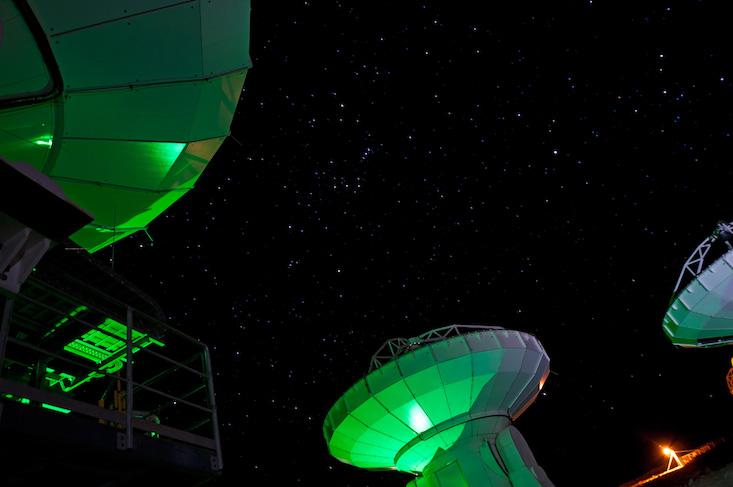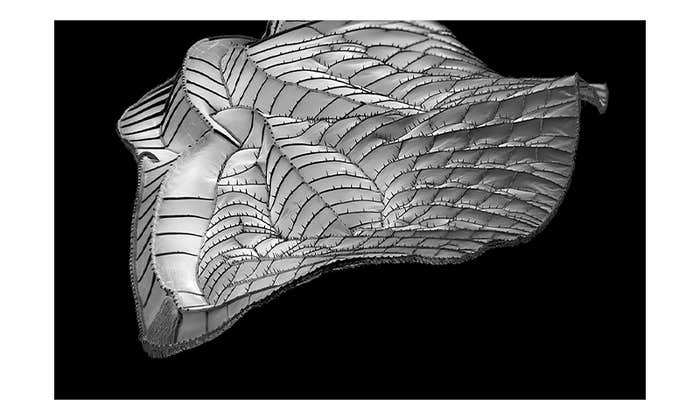Interpreting something from the universe awakens a unique inspiration and curiosity,” says the Swiss electronic musician Lucien Nicolet, who goes by Luciano. He wasn’t waxing mystical. That awakening lead to ALMA Sounds, his latest album, released this month, which features audio derived from one of the world’s biggest astronomy telescopes, the Atacama Large Millimeter/submillimeter Array (ALMA). Scientists turned their observation data—of the Orion Nebula, some 1,300 light-years away—into sound, says Antonio Hales, an astronomer and member of the telescope’s scientific operations team in Chile. It’s just another way the public, he says, could “feel inspired by what we’re doing.”
The project, like the album, is also called ALMA Sounds, and offers hundreds of high-pitched chirps and low metallic drones, created by the project’s own software, free for anyone to download. Felipe Venegas, a Chilean DJ and producer—also featured on the album with Luciano—calls the opportunity to use sounds derived from deep space “something that any composer from yesteryear, like Beethoven or Mozart, would have loved to have.” (Minimalist composer Terry Riley incorporated sounds collected by NASA spacecraft, including Voyager, Galileo, and Cassini, into his 2002 work, Sun Rings.)
Before the art came the science. The Array has 66 antennas, dishes weighing 100 metric tons each, working in unison to capture radio waves, which “carry information about the chemical composition and other things about the source,” Hales says. They can be used to identify atoms—even complex molecules like water, sugar, and alcohols—drifting in space. They can even determine a source’s velocity thanks to the Doppler effect, he says, a crunch or stretch in emitted particles’ wavelengths depending on whether an object is moving toward or away from its observer.
The data for ALMA Sounds was gathered in 2012, the year before the telescope’s inauguration, for a process of verification. Bright and relatively close to Earth, the Orion Nebula had already been observed with previous telescopes, “so we had to use it as a benchmark for understanding the performance of the instrument,” Hales says. If the Array’s data checked out with what was previously known about the nebula, the world’s astronomy community—the $1.4 billion telescope was funded by governments around the world—could feel confident about its data. “We were really, really focused on making the bloody thing work,” Hales says.

The Atacama Desert, the Array’s base, is the driest place on Earth, making it ideal for receiving radio waves since any moisture in the atmosphere absorbs them. “If you get above 40 percent of the atmosphere in the location where the column of air above you is pretty darn dry,” says Charles Blue, a spokesperson for the National Radio Astronomy Observatory, which participates in operating ALMA, “it makes it a pretty effective place to look for millimeter and sub-millimeter objects,” he says. The Array’s antennas greet the sky 5,000 meters above sea level, not far below Everest Base Camp, in Tibet. (Like some of the adventurers in the Himalayas, the Array’s site is equipped with oxygen tanks to counteract altitude sickness.)
These extreme conditions help make it more precise than any of its predecessors. Recently, it was used to measure the mass of a huge black hole centering NGC 1332, an elliptical galaxy 73 million light-years away (not located in Orion). “If you want to see the entire universe for what it is, you need to have something that can see in radio and in millimeter as well,” Blue says. (Millimeter and submillimeter waves describe high frequency radio waves and beyond, including microwaves and some far-infrared waves.) “The Array typically looks at the colder, more distant objects because the majority of things in the universe are not hot and giving off light—they’re the cold clouds of gas.” These vast webs of matter sometimes collapse into stars, making the Array a precious lens for learning more about how these celestial bodies are born. “The unlocking of the cosmological mysteries,” as Carl Sagan put it, in Cosmos, “requires us to use exotic instruments and frequencies different from the visible light to which our eyes are sensitive.”
“It’s just beautiful to see how clearly ALMA resolves the rotation of these gaseous disks in galaxy centers.”
To determine the mass of the black hole anchoring NGC 1332, researchers used the Array’s data to clock the speed of carbon monoxide molecules orbiting it. NGC 1332’s black hole turns out to be 660 million times more massive than the sun. Previous estimates by other telescopes ranged from 500 million solar masses to nearly thrice that. “The quality of the ALMA data is absolutely stunning,” says Aaron Barth, an astronomer at the University of California, Irvine, who lead the black hole study, published in May on arXiv. “It’s just beautiful to see how clearly ALMA resolves the rotation of these gaseous disks in galaxy centers.”
So how did ALMA Sounds go about turning that kind of data into sound? The Array’s range of interest is “way above any commercial application”—like FM radio frequencies, for example—“and military radars don’t go that high up in frequency,” says Ricardo Finger, the electrical engineer behind ALMA Sounds. Specifically, the data for the project was taken from a window about 2 gHz wide somewhere between 90 and 116 gHz. Those frequencies would be orders of magnitude beyond anything humans (or any animal) could perceive, so these were lowered by some 20 octaves to fit into the human hearing range.
A software program created by Finger then turned this data into a sine wave of differing volume levels (sine waves get their name from their smooth, repetitive, oscillating shape on a graph; they sound similar to the beep reminding you to fasten your seatbelt on an airplane). And through the magic that is additive synthesis—“any sound can be translated into a sufficiently large list of sine waves,” Finger says—the result is one of the various sounds available for download.
In order to give musicians some familiar ingredients for beat making, Finger’s program also sped up some of the samples, which has the effect of increasing their pitch and turning them into short percussive sounds. That was one of the few deliberate decisions made in crafting the sound bites for ALMA Sounds. “We were trying to put as little human in there [as possible],” Hales says. The majority of the human part—composing the sounds into music—they left to the artists themselves.
Pierre Bienaimé is a writer and musician based in New York. He’s on Twitter as @ScribblerSounds.
The lead photograph is courtesy of Cyril Rana via Flickr.






























